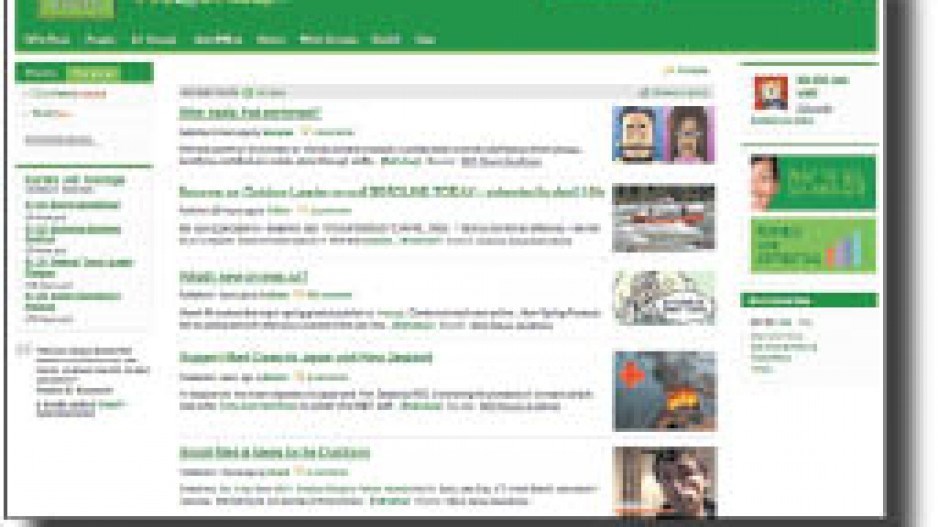If you’re the head of a large company or organization, you may have been pitched at some point – probably by your HR department – on implementing an enterprise social network.
Think Facebook for work, but with a suite of collaboration tools added on: departmental calendars, document-sharing platforms and inter-office messaging, to name a few.
You may have pictured thousands of hours of company time going down a “social notworking” black hole.
In fact, companies that have implemented social intranet have found productivity, collaboration and knowledge retention goes up, said Gordon Ross, vice-president strategy and co-founder of ThoughtFarmer – one of Canada’s most popular social intranet developers.
The Guardian newspaper, eHarmony, Mountain Equipment Co-op and Vancouver Airport Authority are just a few of ThoughtFarmer’s 100 clients.
“It becomes very apparent, very quickly, that it’s a productivity tool,” Ross said.
One of the first things companies with social intranet notice is that email congestion goes down.
“Email was the killer application that allowed us to work so much more effectively about 20 years ago,” said Ron Shewchuk, a business communications consultant, who was a guest speaker at the recent Social Intranet Summit 2011 in Vancouver. “Today it’s the application that’s killing us.”
Joey Dubuc, Internet site administrator for MEC, said email is still valuable for some internal communications, but that the social intranet it implemented a year and a half ago – called Mondo – has replaced a lot of internal emailing.
“What it’s done, for a lot of people, is that it has just shrunk down the ever-growing pile of emails and kept more global communiqués and collaborative communiqués down to a minimum in the mailbox and just moved it over to Mondo.”
Many large organizations already have intranet. They are typically static, one-way communication platforms. Internal social networking – also known as enterprise social networks or Web 2.0 – is more like Facebook or LinkedIn because everyone on the site has a bio and can post content without having to go through a webmaster.
For some managers, that raises the spectre of employees gossiping or even sniping at each other publicly. In fact, that rarely happens, Ross said.
“People very quickly understand that there’s an audience,” he said.
One of the benefits of social intranet is that it helps people within an organization learn who their colleagues are, what they do and what they are working on.
“You can have a 50-person company and not know the person across the hall from you,” Shewchuk said.
That employee alienation tends to be most pronounced in companies or organizations where employees are spread throughout multiple branches.
Vancouver-based Global Container Terminals has only 325 employees, for example, but nearly half of them are 3,919 kilometres away, in New York State. The company runs two shipping terminals in Vancouver, one in New Jersey and one in New York.
In April, the company went live with GCT360, a ThoughtFarmer site, with the hope it would bridge that gulf.
“We really wanted to have a place where people can collaborate and communicate across the regions,” said Peter Miedema, Global Container Terminals’s CIO. “The people from east and west really didn’t know each other before.
“It’s more than just social media. It’s truly a tool to share information and to work together on projects.”
MEC has an even greater geographic disconnect. The co-op has 1,500 employees in 14 locations spread across Canada.
A ThoughtFarmer intranet case study shows employee engagement at MEC is up, thanks to Mondo, which MEC staff can access from work or from home. Since front-line retail staff at MEC don’t have company emails or computer terminals, being able to access Mondo from home gives them access to organizational information they never had before.
In addition to news feeds, social intranets can also host calendars that allow everyone in the organization – or a specific department – to review project deadlines, see when and where meetings are scheduled, or who may be on vacation, working from home or off sick. They also typically offer document sharing and wiki functions that encourage and facilitate collaboration.
If you are putting together a PowerPoint presentation, for example, or an annual report that requires input from colleagues, your cohorts can work on the same document from their intranet site and they don’t even have to be in the office to do it.
ThoughtFarmer recently launched a mobile web application that even allows users to access their sites on their smartphones or tablets.
One of the most valuable functions of social intranet is that it allows organizations to retain knowledge, even after employees leave, Ross said. With large numbers of baby boomers set to retire over the next decade, knowledge retention could become increasingly important, he said.
“When that person walks out the door, you lose what they know,” Ross said.
Social intranet can be used as an “institutional memory” because all of the work and communications ever done by employees is retained within a searchable database.
“It has permanency through time and it’s publicly available,” Ross said. •




